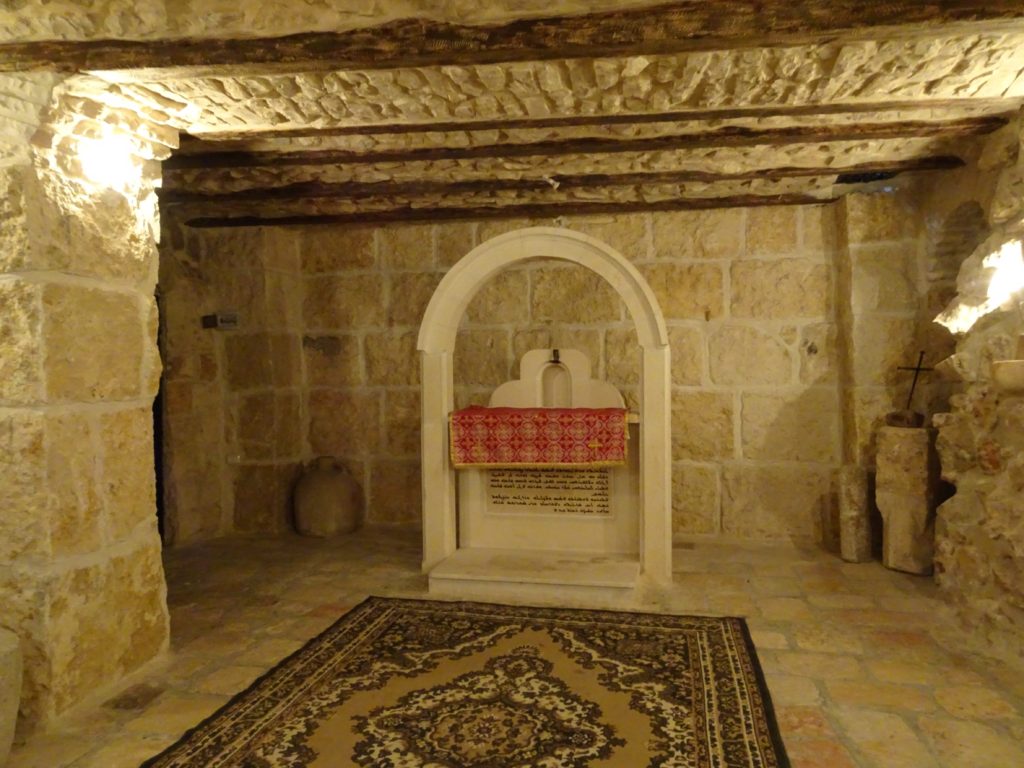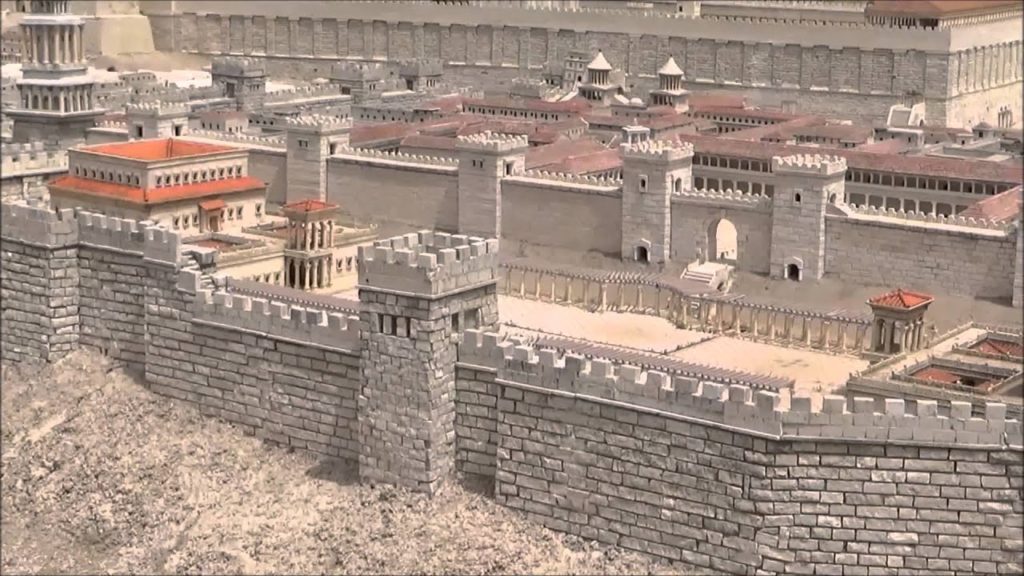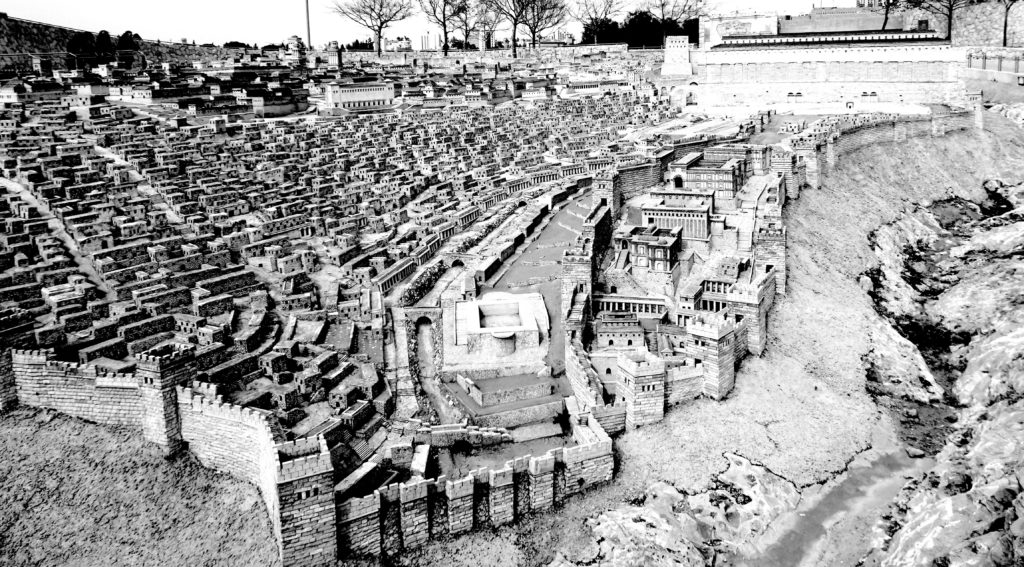WHAT HAPPENED WHERE?
Holy Week and the Problem of Place
Introduction
It is always moving to walk about Jerusalem and try to retrace the actual footsteps of Jesus, most famously along the Via Dolorosa. But Jerusalem has been destroyed and rebuilt so many times that we can’t be sure if the traditional locations are the actual ones. So what follows are a series of informed guesses.

Writing ‘Jesus the Troublemaker’
I have been to Jerusalem a total of seven times, from 1963 to 2017. Every time I go I make a point of visiting the model of 1st century Jerusalem in the Israel Museum. (The first time I went, in 1963, I saw it in the grounds of the Holyland Hotel, West Jerusalem, whose owner had had it made to compensate for the fact that the Old City was in the Jordan-controlled part of Palestine). It really is possible to trace out Jesus’ movements.
I believe that Mark is the most reliable account. But recently I have been persuaded by the books of Richard Baukham that John was written by an eyewitness, a Jerusalem disciple called John, in the manner of a classical history. So I take his testimony seriously. So here are some of the puzzles:
- 1 In whose house did Jesus have the feast at Bethany, in the house of Lazarus, or of Simon the leper?
- 2 Where was the house where Jesus had the Last Supper?
- 3 Where did the trials of Jesus take place?
- 4 Where did Pentecost happen?
The Feast at Bethany
We know that Jesus made Bethany his headquarters, about an hour’s walk form Jerusalem. It was probably quite a large village because it was an easy commuting distance to Jerusalem. Its name means ‘House of Affliction’ so in my book I have invented a large charitable hostel for poor people, specially widows and orphans.
- Mark says that the feast was held at the house of Simon the leper, and an unnamed woman anointed Jesus’ head with oil (Mark 14.3-9).
- Matthew copies Mark but omits the feast (Matthew 26.6-13).
- John implies that the feast was at the house of Lazarus, Martha and Mary, (John 12.1-8). So who’s right?
My solution is that they both are. This is based in that Jesus had a large circle of close followers. We know of the twelve key disciples, all but one from Galilee. And probably an equal number of women disciples. We are given the names of three of them; ‘these used to follow him and provided for him when he was in Galilee; and there were many other women who had come up with him to Jerusalem.’
Let’s say there were two dozen in Jesus close circle. Where did they stay on the days before and after Passover? No private house could accommodate that number. And I think that men and women would have been accommodated separately.
My solution is that the men stayed at the house of Simon the leper, and the women stayed with Lazarus, Mary and Martha; that the feast was held in the house of Simon the leper (as in Mark) but that Lazarus’ household, including Mary and Martha, helped in the substantial catering. Whether or not that is what happened, something like that must have happened.
The House of the Last Supper
The gospels don’t tell us where the Last Supper was held, except that it was inside Jerusalem. It was clearly a substantial property. The family were wealthy enough to have at least two household servants or slaves (one male, one female), and have a large comfortable first floor room (Mark 14.15). We are then reliant on Jerusalem traditions. One is that it is ‘the cenacle’ a Crusader chapel on the site of much earlier churches and possibly of an ancient synagogue, on Mount Zion, on the south-west corner fo the city, possible in the Essene quarter.
The other is the Syrian Orthodox claim that the church of St Mark in the Old City is the actual place. Having spent some time in the basement, which they say is the actual room of the Last Supper. Habitation levels have risen that much over the centuries. I favour their claim.

It does not make much difference, except that if the former is the case, the way to Gethsemane would have been south though the Valley gate, with a steep descent to and ascent from the river Kidron to Gethsemane.
If the latter is the case, my calculation is that it would have been in the heart of the Upper City, between city market and the amphitheatre; the nearest route to Gethsemane would have been to go north through a gate by the Hippichus tower, and thus would have passed right by Golgotha. A dramatic scene I could not resist.
The Trials of Jesus
The number of trials that Jesus had to undergo vary from two (as in Mark) to five (if you add all the gospels together). I go with all five, because they make sense if you get the locations right.
1 Trial under Annas, the former high priest (John 18.12-24).
Not strictly a trial but an informal investigation. It would have been about midnight, so illegal as a trial under Jewish law. It makes sense geographically, because the squad would have taken Jesus from Gethsemane, past the Roman Antonia fortress and into the Upper City past the Hasmonean palace. The Hasmoneans had been high priests and rulers of Judaea for a century before Herod seized power. Annas probably occupied a wing of the palace.
2 Trial under Caiaphas (Mark 14.53-65)
Caiaphas had been the official high priest for about sixteen years. He was the son-in-law of Annas. His palace was at the other end of the Upper City, as shown in the model of Jerusalem in the Israel Museum.
Many commentators assume that the trial under Caiaphas took place in the official hall of the Sanhedrin, the Hall of Polished Stone, (or Hall of Uncut Stone) in the Temple, next to the Court of Israel. It was big enough to seat the full Sanhedrin of 71 members.
The other possibility is that Jesus was tried in Caiaphas’ palace. The hall there would not have accommodated 71, but it would have held the minimum quorum of 23 members. It was very much nearer Pilate’s headquarters, and less in the public gaze. It was also equipped with a dungeon, useful for holding prisoners, as archaeologists have recently discovered. I have assumed that Jesus was held there while Caiaphas got together a council and witnesses ready for a trial at the break of day, i.e. 6.00a.m.
3 First trial under Pilate (Mark 15.1-5, Luke 23.1-5, John 18.28-32)
Where was Pilate’s headquarters in Jerusalem? Some have suggested in the Antonia fortress, suitable for Pilate’s essentially military appointment. But where would the crowd have gathered? Surely not inside the fortress. Perhaps at the foot of the steps leading up to the fortress, as happened to Paul in Acts 21.33-36. Possible, but not very dignified.
Possibly in the colonnade which has been found near the start of the current Via Dolorosa, near St Stephen’s Gate. Sadly not. That was built after the destruction of Jerusalem as a Jewish city in 135. In Jesus’ time, it was a system of enormous water cisterns.
Let’s look at the palace which Herod the Great had built fifty years before. This was an enormous site, occupying the whole western wall south of the Jaffa Gate. It had two separate palaces at each end. I suppose that Herod’s palace was occupied by his successor Archelaus. When he was deposed by Augustus in 6 AD, it seems that one wing was taken over as a barracks for Roman forces. The other I suppose was given to Herod Antipas, the ruler of Galilee and Trans-Jordan.

We are given two names in John 18.13 for the area where Jesus was interrogated by Pilate. ‘Lithostrotos’ means a pavement made upon mosaic work – extremely expensive. I found some such flooring when I helped excavate Herod’s palace at Masada in 1963. The Hebrew ‘Gabbatha’ means ‘raised up’. And the pavement of Herod’s palace was indeed raised up from street level by some fifteen feet.
So the old palace of Herod the Great was where I believe Jesus faced Pilate – only 5 minutes’ walk from Caiaphas’ palace, and only ten minutes’ walk from Golgotha.
Also, the fortified entrance to the palace was directly the City Market, a natural place in which to gather a crowd before entering the palace precincts.
The first investigation by Pilate was outside, under the main porch, so that the Jewish leaders would not have to enter Gentile living quarters (John 18.28).
4 Trial under Herod Antipas (Luke 23.6-12)
This location makes sense of the Jesus’ interrogation by Herod Antipas. It was less than five minutes’ walk from Pilate’s Praetorium to Herod’s palace, an easy, indeed a natural thing to do.
5 Second trial under Pilate (Mark 15.6-15, Luke 23.13-25, John 18.33 – 19.16)
The second interrogation between Pilate and Jesus was a private one, inside the governor’s headquarters (John 18.33).
The model of the palace in the Israel Museum shows a large first floor balcony overlooking the mosaic pavement, from which Pilate could have addressed a crowd of Jerusalem citizens.
The praetorian or barracks or palace had a large inner courtyard, where I assume the scourging took place.
Pentecost
We do not know where the ‘one place’ was where the Holy Spirit fell on the followers of Jesus when they were ‘all together’ – all 12 (Acts 1.26) or all 120 (Acts 1.15). Perhaps the same house as where they had had the Last Supper, including the courtyard. But for anyone who has visited the model of Jerusalem in the Israel Museum, there is only one open space a few thousand people could have gathered, and that is in front of the southern ‘Huldah’ gates of the Temple, near the Hippodrome or racing stadium. There there was a gigantic flight of steps there, ideal for Peter to stand and address the crowd. And from there a straight walk down through the Lower City to carry out the baptisms of 3,000 converts in the river Kidron.

Moral
The moral of this story is that, if you ever visit Jerusalem, make sure you spend at least half a day in Israel Museum!
